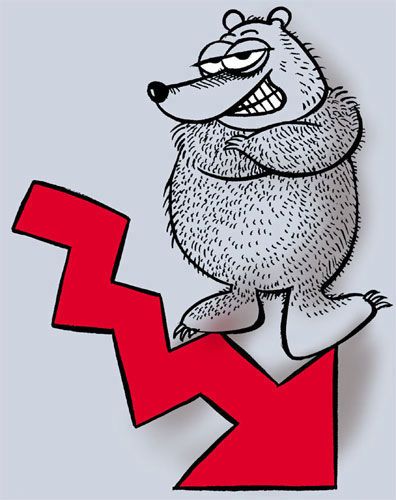 | « Back to article | Print this article |
The rupee has lost ground since pre-Budget, against three major hard currencies (yen, dollar and euro). The European Central Bank and the Bank of Japan maintained status quo in recent policy meetings
Illustration: Uttam Ghosh/Rediff.com
The market broke down from a trading zone and it now appears to heading into what could be a long-term bear market.
The Nifty was trading a zone of 10,300-10,600. Once a key support at 10,275 broke, the likely target would be about 10,000.
That is well below its own 200-Day Moving Average ( 200-DMA), which is currently around 10,150.
On Friday, the Nifty dropped below its 200-DMA when it closed at 10,094. A move below the 200-DMA generally indicates a long-term bear market.
 The short-term trend is clearly negative.
The short-term trend is clearly negative.
The next bounce, on short-covering is likely to come along soon. But, the zone at 10,275-10,300 is now likely to provide stiff resistance.
A quick rebound beyond 10,300 could lead to another phase of range trading. The VIX has climbed, which does indicate fear.
Breadth was negative and there's more volume in net losers.
Domestic institutional investors and foreign portfolio investors have been net buyers in March.
The net losses therefore, have come on the back of heavy retail selling.
Obviously, sentiment has broken down on the back of political reverses the BJP has suffered.
The rupee has lost ground since pre-Budget, against three major hard currencies (yen, dollar and euro). The European Central Bank and the Bank of Japan maintained status quo in recent policy meetings.
But, both central banks indicated that respective QE programmes will be phased out in 2018.
That will mean a tapering of easy money at some stage and the euro and yen could harden as a result.
If the Nifty stays below the 200-DMA for any length of time, say, the next three or four sessions, it would be time to call a long-term bull market.
The intermediate trend is obviously negative with falling peaks and bottoms.
The short-term trend could reverse soon as short-covering must be around the corner, given a 3 per cent slide.
Trend-following signals suggest holding a sell on the Nifty with a stop at 10,300.
The Index has bounced twice from 9,675 since December 2016.
If the 200-DMA breaks, the 9,675-9,700 region would be the next support.
The signals out of the bond market remain negative with G-Sec yields rising despite better inflation data in February.
The Reserve Bank of India is expected to maintain status quo in its April 5 meeting.
Sentiment has been especially badly affected in banking and financials.
The Nifty Bank has slid from 27,200 on the Budget day to hit current levels of 24,250.
That's well below the 200-DMA, which is at 24,800. The sector is already in an extended bear market.
Given the trend, a bearspread with long March 28, 23,500p (116), short 23,000p (55) may be profitable.
This costs about 61 and it breakevens at roughly 23,440.
It could be hit in three big down trending sessions.
The contrarian take would be to look for a bounce till 25,000 on short covering.
In that case, consider a long March 28, 25,000c (92), offset by short 25,500c (27). This costs 65 and breakevens at 25,065.
The Nifty closed at 10,094 on Monday. There are only seven sessions to settlement.
The put-call ratios are not very meaningful. A straddle of long 10,100c (109), 10,100p (91) costs 200.
A bullspread of long March 10,200c (63), short 10,300c (32) costs 31, pays a maximum 69 and it's about 106 points from money.
A bearspread of long March 10,000p (58), short 9,900p (35) costs 23, pays a maximum of 77.
This is about 95 points from money.
The combined long-short strangle would cost 54, with breakevens at 10,254, 9,946.
One or the other side is likely to be hit.
Take the bearspread or take the long-short strangle if you expect a bounce.